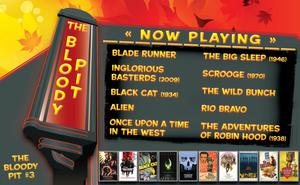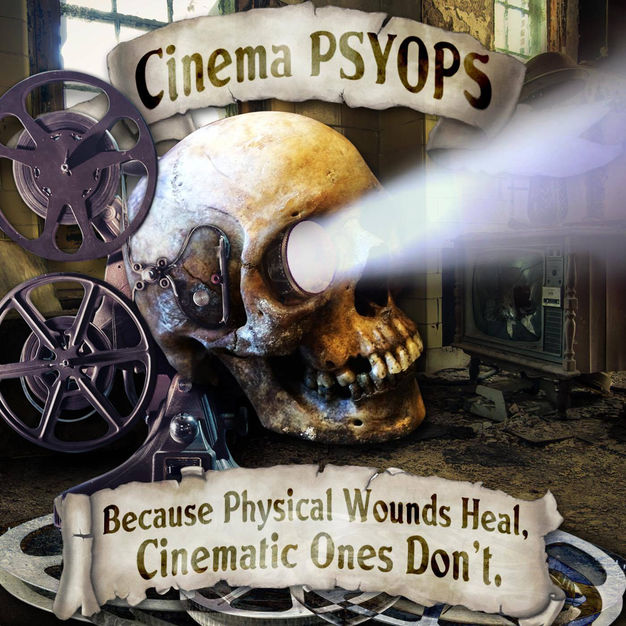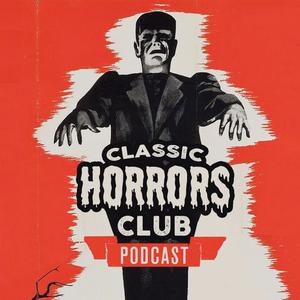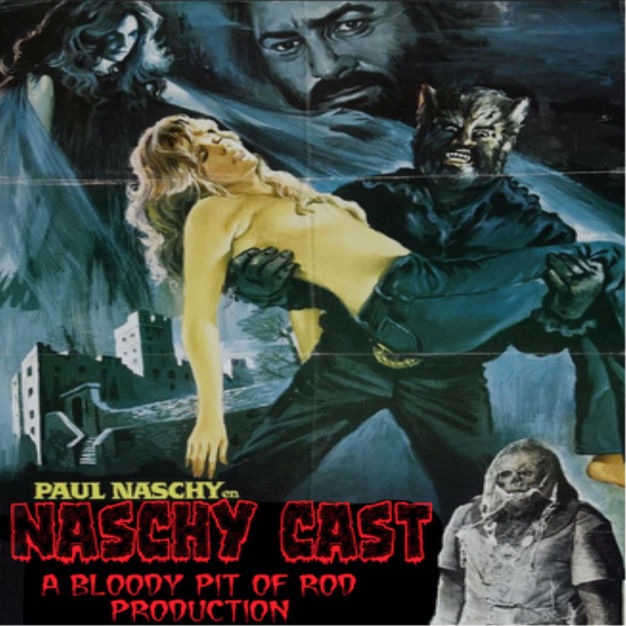
The Bloody Pit
Rod Barnett
Let's Talk About Cult Movies and TV!
- 1 hour 15 minutes209 - FRANKENSTEIN'S DAUGHTER and MISSILE TO THE MOON (1958)
This episode is the second part of my discussion of the films of Richard Cuhna with author Mark Clark. We focus on FRANKENSTEIN’S DAUGHTER and MISSILE TO THE MOON (1958) before we ramble off into talking about the Planet of the Apes franchise. Staying on topic is difficult for both of us!
The cast of FRANKENSTEIN’S DAUGHTER (1958) is examined with lots of love directed at the amazingly villainous Donald Murphy as a descendant of grandaddy Frankenstein. One could only imagine what his character might have accomplished if he could gain some control over his libido. We look at the various funding methods used by mad scientists and the ways that suburban homeowners can somehow forget entire areas of their house exist! We also lament the lack of Jack Pierce’s contributions to the monster makeup and wish he could have returned after his work on GIANT FROM THE UNKNOWN as the film’s monster look is oddly non-gender specific. As a science fiction/horror tale, the movie actually has a very rare pair of competent police officers, although their detective skills don’t mean they will live through the investigation.
When our conversation turns to MISSILE TO THE MOON (1958) we praise the excellent rock monsters and a few of the performances but struggle to find more to love. Perhaps shifting from original screenplays to remaking a not very good film wasn’t the best idea for Cunha and his collaborators. Still, there are things to enjoy in the movie, especially if you have a soft-spot for 50’s science fiction tales told with more enthusiasm than fidelity to reality.
If you have any thoughts about the four genre films directed by Richard Cunha [email protected] is where to send them. We both love these movies and return to them regularly. With some luck the missing two can be rescued from YouTube by an enterprising Blu-Ray company soon.13 January 2025, 4:43 pm - 1 hour 32 minutes208 - GIANT FROM THE UNKNOWN and SHE DEMONS (1958)
Author Mark Clark joins me for the first of two episodes focused on director Richard Cunha’s genre films. In 1958 Cunha directed four horror/sci-fi movies that have stood the test of time. This episode focuses on the first two of these little gems, GIANT OF THE UNKNOWN and SHE DEMONS which were originally released as a double feature.
We both love these movies and have a good time digging into them. We end up discussing some production background and the casts as well as the reasons we think they are so charming. Each of them is a typical black & white 50’s monster movie but with some peculiar choices made in presentation. As independent productions these films show a quality we refer to as feeling ‘handmade’ that gives them a different vibe from other movies of the times. The stories are similar to the b-movie hits of their decade but a number of the creative choices made are what makes them unique. If you’ve never seen the Cunha films, two of them have been released on Blu-Ray recently and they are available on YouTube as well. Our next episode will focus on the final two films.
If you have any comments on the four Richard Cunha directed monster movies [email protected] is the place to send them. Thank you for listening!
30 December 2024, 3:12 pm - 1 hour 43 minutes207 - BLACK CHRISTMAS (1974)
December brings our annual Holiday Horror episode. This year we discuss the legendary Canadian film BLACK CHRISTMAS (1974) and we have much to say. Turns out this is our tenth year of this Holiday tradition which surprised and slightly freaked me out. But Troy Guinn and John Hudson are rightly proud of our decade long series and glad to finally talk about the one that might have started the whole sub-genre. Sadly, our ages are starting to show, starting with the fact that none of us can remember when we first saw this classic horror film. Very strange.
We dive right in and forego the usual plot synopsis in hopes that listeners will have seen the movie. We lament that we have never been able to read the 1976 novelization and note that a brand new one is coming out any day now. We talk about the actors quite a lot with Troy boldly stating that this is the best ensemble cast of any slasher film ever. Others may disagree. We take the time to point out that phone technology and the concept of an ‘obscene phone call’ seem to have gone the way of the 8-track tape. And we discuss the sure directorial hand of Bob Clark while lamenting his 1990’s career slide into profitable but inane children’s films. Also, we ask the serious question of whether John Saxon ever actually solved a crime onscreen. This will require research!
If you have thoughts on BLACK CHRISTMAS (1974) or any other Holiday Horror [email protected] is the place to send them. Thank you for listening and beware of attic monsters.
16 December 2024, 3:02 am - 1 hour 47 minutes206 - PEARL OF DEATH (1944)
Basil Rathbone and Nigel Bruce return to the show! I am joined by Beth Morris and Troy Guinn to discuss the next in Universal’s long running Sherlock Holmes series featuring the legendary detective in the 1940’s. This entry uses one of Arthur Conan Doyle’s original short stories to provide the basic plot – or does it? We look at the film’s very strong ties to a certain American crime fiction writer’s famous story that the script seems to borrow from. Is this a mash-up of two tales that taste great together?
THE PEARL OF DEATH (1944) is a movie that doesn’t spring to mind as one of the best of the Universal Holmes films but perhaps it should. The series’ regulars are in fine form and returning guest actor Evelyn Ankers gets a lot to do as the main female baddie. She seems capable of getting any job in London and can disguise herself effectively in the bargain. In fact, this film has her character, Sherlock and the lead bad guy Giles Conover so often pretending to be someone else that it plays like there is a contest between them! And the film also sports the first screen appearances of Rondo Hatton as The Creeper. We talk a good deal about the way the plot unfolds and take note of how the screenplay seems to be digging into a Holmes character flaw to drive the story. Of course, there are the usual odd asides including a Tolkien reference that is quite out of place and a short debate about the correct size of a Yamaka or skullcap. We try to use our meager deductive reasoning skills but we tend to be more Watson than Holmes.
Thank you for listening to the show and [email protected] is the place to send any thoughts. Stay warm and we’ll be back soon.
30 November 2024, 1:26 am - 1 hour 33 minutes205 - STRANGLER OF THE SWAMP (1946)
Author David Annandale joins me for the second time to talk about another 1940’s horror film! This time we wade through STRANGLER OF THE SWAMP (1946) which is one of the more interesting examples of the output of the smallest of the Poverty Row studios - PRC (a.k.a. Producer’s Releasing Corporation). This is a fascinating low budget film that manages to make its lack of resources a virtue by leaning into the creepy fog and mists to hide the set limitations. It’s a favorite of both of us and we love getting to talk about it.
STRANGLER OF THE SWAMP is actually a remake of a German movie made by the same director a decade before. We start the show by digging into the earlier film to compare the two and delineate their many differences. The American film is much more a horror tale than the 1936 German original with a dark foreboding hanging over the characters living in an isolated village. The 1946 film has the vengeful ghost of a wrongfully accused man stalking and strangling the men responsible for his death and extending his attacks to the male children of the families as well. Having watched this moody little gem repeatedly over the years we were surprised to only now take note of the heroic town mothers the movie presents. While the men flail around trying to find a ‘reasonable’ excuse for the horrific events the female population works to deal directly with the problem. We note that this story element might be related to the changing view of women’s place in society during the second world war and wonder if this was a conscious choice by the filmmakers. We may never know, but it shows just how intriguing this little film can be and points to how creativity can make a movie endlessly rewatchable. There are always thought-provoking things buried in this swamp to drag out of the muck!
Mr. Annandale and I last discussed THE MONSTER MAKER and that episode can be found here. If you have any comments about this film or any other Poverty Row horror film [email protected] is the place to send them. Thank you for listening!
15 November 2024, 1:36 am - 1 hour 26 minutes204 - REANIMATOR (1985)
REANIMATOR (1985) was a pivotal moment in horror filmmaking for several reasons. First among them is that it announced the arrival of a major talent behind the camera – director Stuart Gordon. His screen career remains a wonder and with this episode we start a series in which we will examine the entirety of his directorial efforts. We might even take a look at the projects that he was involved with but were directed by others.
I am joined by John Hudson to talk about this amazing film. We touch on the original 1922 H.P. Lovecraft story ‘Herbert West – Reanimator’ and the creation of this adaptation starting as a possible television show to eventual big screen incarnation we now know. The cast is discussed with a general amazement at the near perfect choices made for each role. We note that even though this was Gordon’s first feature film, his years of stage experience seems to have allowed him to understand both actors and audience in ways that translate well to cinema. It would be difficult to find a more sure-footed first movie. We talk about the dark humor that permeates the story including what has been called the world’s first visual pun. Mostly we spend our time heaping praise on this one and explaining our love for it so be aware!
If you have any comments [email protected] is where to send them. We’ll return to the films of Stuart Gordon as soon as possible. Thank you for listening!
25 October 2024, 11:40 am - 1 hour 33 minutes203 - THE MUMMY'S GHOST (1944)
Troy and I return to the quartet of mummy movies that Universal released in the 1940’s! This time we examine one of the best of the lot, THE MUMMY’S GHOST (1944). The film has a number of great elements including an underappreciated heroic dog named Peanuts! As with all of these movies, the limping rhythms are the same but it’s the style and energy of the piece that makes it a standout.
We discuss the three decade time jump from the previous movie and marvel at 1970’s technology. The age of college students becomes a source of amusement as does the ineffectuality of the local police’s attempts to capture the rampaging mummy. We talk a bit about the cast, noting where we’ve seen a number of the players before in Universal horror pictures. There is some speculation on the possible health effects of being shot at point blank range given that George Zucco’s character from the last film is still alive decades later. And we are pleased to point out the rare chance to physically emote that Lon Chaney is afforded in a few scenes. Is this his best performance as a mummy?
If you have any comments on the Universal mummy movies or any other film we’ve covered [email protected] is the place to send them. Thank you for listening.6 October 2024, 2:10 pm - 1 hour 37 minutes202 - THE RETURN OF CHANDU (1934)
My friend Chris Herzog joins me to talk about a serial from 1934 – THE RETURN OF CHANDU! Chris hasn’t been on the show since we discussed the Johnny Weissmuller Tarzan films back in episode #15. It was Bela Lugosi’s starring role that enticed him to come back for a conversation about this fantasy adventure in which the legendary horror actor plays the heroic lead! That’s right - Lugosi is the hero in this twelve-part serial. Will wonders never cease?
We discuss the radio show Chandu the Magician, from which this was adapted and the 1932 film that preceded this production in which Lugosi played the villain, Roxor. Neither of us can think of another sequel that recasts the hero to be played by the actor who portrayed the bad guy in the original, but that’s what happened with Chandu. We talk about the director’s work in Hollywood and his other serials as well as his work with the great William Whitney. We point out the reused sets from KING KONG and marvel at the giant cat statue in the Lemurian temple set. Cool stuff! And we lament that Chandu’s family seems to have been put on this earth to serve as eternal victims in need of rescuing. You think he could have let one of them die just to get the others to stay home next time!
If you are a Bela Lugosi fan or a fan of his various serials thebloodypit@gmail is the place to let that flag fly. And if you enjoy the show let us know. Thanks for listening.24 September 2024, 12:34 am - 1 hour 49 minutes201 - BLAKE'S 7 (1978-1981)
Author John Kenneth Muir returns to the show to discuss another science fiction television show! BLAKE’S 7 aired in Britain from 1978 to 1981 and was a major hit but was not renewed for a fifth season. That the show remains beloved decades later points to the typical short sighted BBC decision making process in such matters. With the recent announcement of Blu-Ray releases we decided that the time was right to talk about the show and our years long love of it. Since Mr. Muir has written a book on the subject, he is the perfect person to speak to about the show which was sold as ‘The Dirty Dozen in Space’. If you’ve never seen the series, we try to avoid most spoilers but a couple of things do leak through as we go along.
Our conversation starts with how we each discovered the show and our initial reactions to the ‘anti-Star Trek’ with the adult nature of the storytelling being our main focus. We discuss the dystopian universe presented and give a brief overview of the ‘rebels vs the federation’ structure of the story. The dark and often cruel tone of the characters and the events they have to deal with is a topic we return to throughout the episode. We also fit in an examination of some of the classic science fiction tropes that the show uses and the creative spin the writers employ to include them. We had a great time digging into BLAKE’S 7 and we hope you will enjoy what we have to say even if you’ve not yet seen the series.
8 September 2024, 3:39 pm - 1 hour 40 minutes200 - FROGS (1972)
Today the pond – tomorrow the world! Author Mark Clark returns to the show to talk about the epic (?) animal attack film FROGS (1972). We discuss that genre as well as the ecological horror sub-genre that this movie falls into comfortably. The goal with this episode was to limit ourselves to a single movie as a way to control the conversation, but that did not happen. Listing other 1970’s eco-horror movies leads to a slippery slope that has us spending a little too much time talking about GODZILLA VS THE SMOG MONSTER. There is no reining us in!
We discuss the cast and crew as we examine the film’s rather relaxed pace. Mark lays the blame for most of the film’s faults at the feet of the director and I have a hard time disagreeing. I admit to being shocked at the naked upper lip of Sam Elliot and remain convinced his character’s name is significant in describing his place in the narrative. I mean, when the rich family being besieged by frogs is named Crockett the writers were clearly playing with descriptive nomenclature. Or they were just having a laugh. But the most interesting part of the show has to be Mark’s theory about why the movie is named Frogs instead of after any of the more deadly creatures that assault the humans in the story. He may have something there but it had never occurred to me before.
If you have any thoughts on FROGS or any of the other ecological horror movies of the 1970’s [email protected] is the place to send them. Thank you for listening!18 August 2024, 3:21 pm - 1 hour 35 minutes199 - JUNGLE WOMAN (1944)
Troy Guinn and I return to Universal Land for the sequel to CAPTIVE WILD WOMAN – JUNGLE WOMAN (1944)! Is this the worst film the studio produced in the 1940’s? We’ll let you decided as we give our opinions and posit ways the film could have been better. Much better!
Attempting to imitate the successful Val Lewton productions at RKO, the producers of this non-jungle epic seemed to feel that simply aping the structure of CAT PEOPLE and copying the memorable set-pieces from that classic would be a winning formula. Sadly, that is far from the case as JUNGLE WOMAN comes up short in every category. Troy and I try to puzzle out the reasons for certain choices and debate the qualities of the acting in the titular role. Of course, any film with J. Carrol Naish has points of interest just because of his talent, but he seems to have been given a number of obstacles to creating a memorable ‘mad’ scientist. A rushed production and a sub-par script are rarely a combination for a classic. On that point, we discuss the film’s dialog with a certain line becoming a reoccurring audio drop in the show. Sorry about that!
If you have any comments about this film or any of the movies we’ve cover [email protected] is the place to send them. Thank you very much for listening. We’ll be back soon.3 August 2024, 3:17 pm - More Episodes? Get the App
Your feedback is valuable to us. Should you encounter any bugs, glitches, lack of functionality or other problems, please email us on [email protected] or join Moon.FM Telegram Group where you can talk directly to the dev team who are happy to answer any queries.
 Cinema PSYOPS
Cinema PSYOPS
 Classic Horrors Club
Classic Horrors Club
 DieCast Movie Podcast
DieCast Movie Podcast
 NaschyCast
NaschyCast
 Monster Kid Radio
Monster Kid Radio